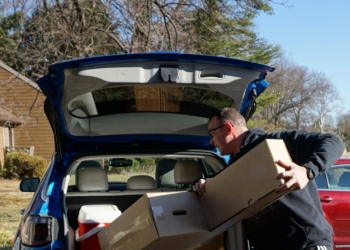Military kids move on average six-to-nine times during a parent’s career so at some point these tips will come in handy. Being organized and knowledgeable about the new school can set your student up for success before the first day of school even comes. Here’s where to start with your planning:
Before the PCS.
Check out the area that you are moving to. Depending on the location, you may be living on or off base and your child’s school options may vary. School ranking sites don’t paint the full picture of what a school or district is actually like. Reviews from parents and former students can help to shape the image of a school but don’t always reflect the actual experiences and education students are receiving.
If your student has an IEP or 504, make sure to discuss at your last meeting of the year that you are moving and to where. IEP and 504 standards may vary by district and state. Arriving with an IEP or 504 that you are comfortable with will help with the transition and will prepare you for the 30 day review that will happen at the start of the new school year.
Know your rights.
Public education policy and curriculum varies from state to state and having the facts can prepare you for most situations.
The Military Interstate Children’s Compact Commission was created to level the educational playing field for military connected students. It is an agreement between all 50 states to provide consistent education and enrollment policies for military-connected children in every school district. The Compact addresses key educational transition issues that military families frequently encounter; such as enrollment, placement, attendance, eligibility and graduation.
School Liaison Officers serve as the primary point of contact for school related matters at military installations. Their job is not only to help parents navigate the local school system, but represent, inform, and assist commands in all matters school related. They work to forge partnerships between the military and schools and can be found at most military installations around the world. If your installation doesn’t have one, then chances are one from another installation is assigned to help in your area.
Military Child Education Coalition.
MCEC is an organization dedicated to supporting education issues affecting military-connected children. They provide materials, programs, support, scholarships and more for military connected students and schools. If you are moving to a non-military area, MCEC is a great resource for school district officials to learn valuable information about military connected students.
[Check out MCEC’s school withdrawal/enrollment checklist at https://www.militarychild.org/upload/files/MSTC%20MSTA/School_Withdrawal_Enrollment_Che.pdf]

Create your child’s student portfolio.
A student portfolio is a student’s educational life story. The portfolio does more than share transcripts and highlight achievements, it should include:
- A photo of your student
- Work samples and report cards
- Standardized test scores
- Transcripts
- Syllabus and course descriptions of high school credit classes
- Parent/Teacher conference documentation
- Life event notes (deployments, separations, significant events)
New school information.
Before you go, be informed. Most school districts provide valuable information via a website. Many even have a tab for new students which includes information on registering your student, school office hours, bus information and upcoming events as well as school year calendars.
Get involved.
While registering your student, ask for the school’s policy on parent volunteers. Let the office know you’re interested in volunteering. Join the parent teacher organization. Show up to all the events at school you can. If you don’t hear of any volunteer opportunities, ask the librarian, they always need help shelving books.
If you and your service member show them a positive attitude about the upcoming move and new beginnings, your student will follow your lead — include them in as much of the planning and research as possible so they can feel in control of a situation that often feels out of control.
Read comments






































